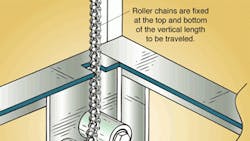Chains for lifting
A major challenge in lifting applications is moving loads at a linear rate while maintaining steady and level positioning on vertical and horizontal planes. One mechanical assembly satisfies these requirements economically: Called a suspended climber, this chain-based lift consists of twin roller chains that are fixed at both ends, plus steel rollers and chain sprockets.
The fixed roller chains are located on either side of a load-bearing platform. In short, as the sprockets climb their way up the chains, the platform and load are lifted. Both sprockets are rotated by a common shaft, which in turn is powered either by an electric motor and transmission, or a step motor. The step motor can be used to position the platform or table.
A suspended climber's cost is lower than that of systems using ballscrews — particularly for systems with longer strokes. In fact, the design's simplicity facilitates cost-effective installation in most plants. The chain lifts can also be built into designs more easily than self-contained units. They move any load, either balanced or unbalanced, where two or more points of support are applied.
This month's handy tips provided by Sam Franklin of Suspended Climbing Systems. For more information, call (918) 698-2426 or visit suspendedclimbingsystems.com.
Q & A
How do its mechanical parts work?
The lift's twin roller chains are secured at both ends and then pretensioned to rigidity. Located on each side of the table are two heat-treated guide rollers and one heat-treated chain sprocket. The platform or table travels along the rigid chain via these roller and sprocket assemblies. The paired guide rollers in each assembly are axially spaced and coaxially parallel; each sprocket is substantially offset perpendicularly from the axis of the paired guide rollers. The guide rollers cause the roller chain to firmly engage the sprocket.
What is the lift's load and speed capacity?
The size of the roller chain, guide rollers, and chain sprocket can be specified to satisfy required capacity. For common industrial versions, maximum suspended-climber speed is 100 ft/min. without lubrication, and 600 ft/min. with lubrication. Similarly, very small versions with miniature chain can lift and lower up to 50 lb; suspended-climber lifts with very large chain can hoist up to 15,000 lb.
What about fatigue?
The lift doesn't bend its roller chain around the sprocket — so it has almost none of the wear and fatigue problems associated with steel cable used for the same application.
